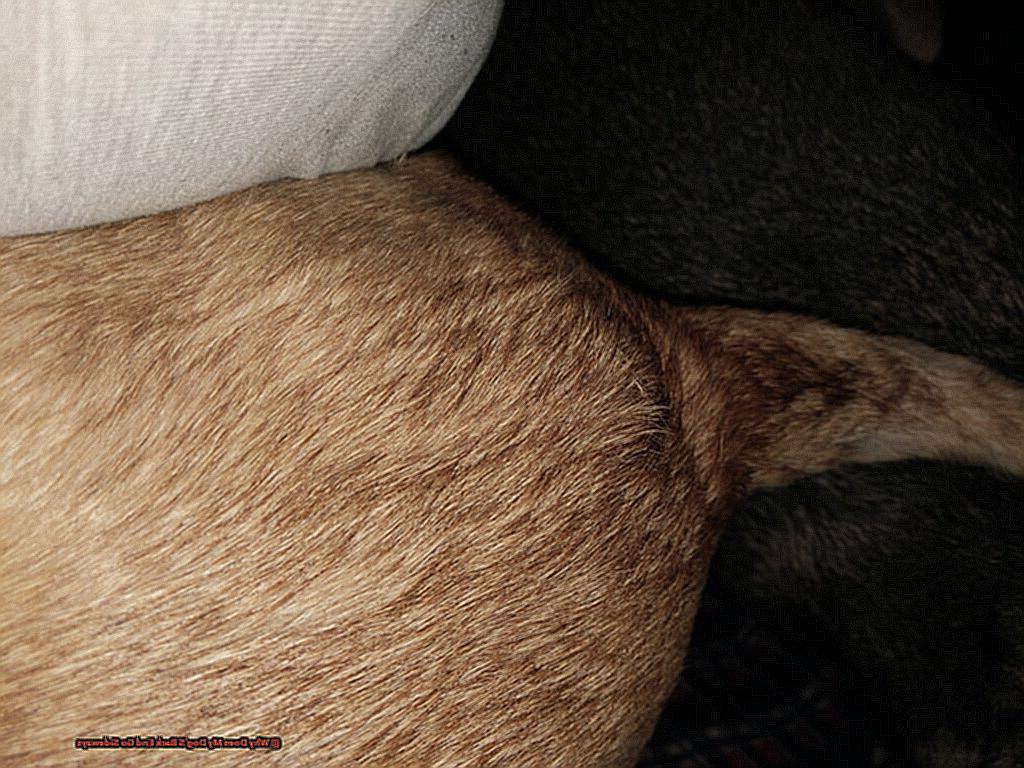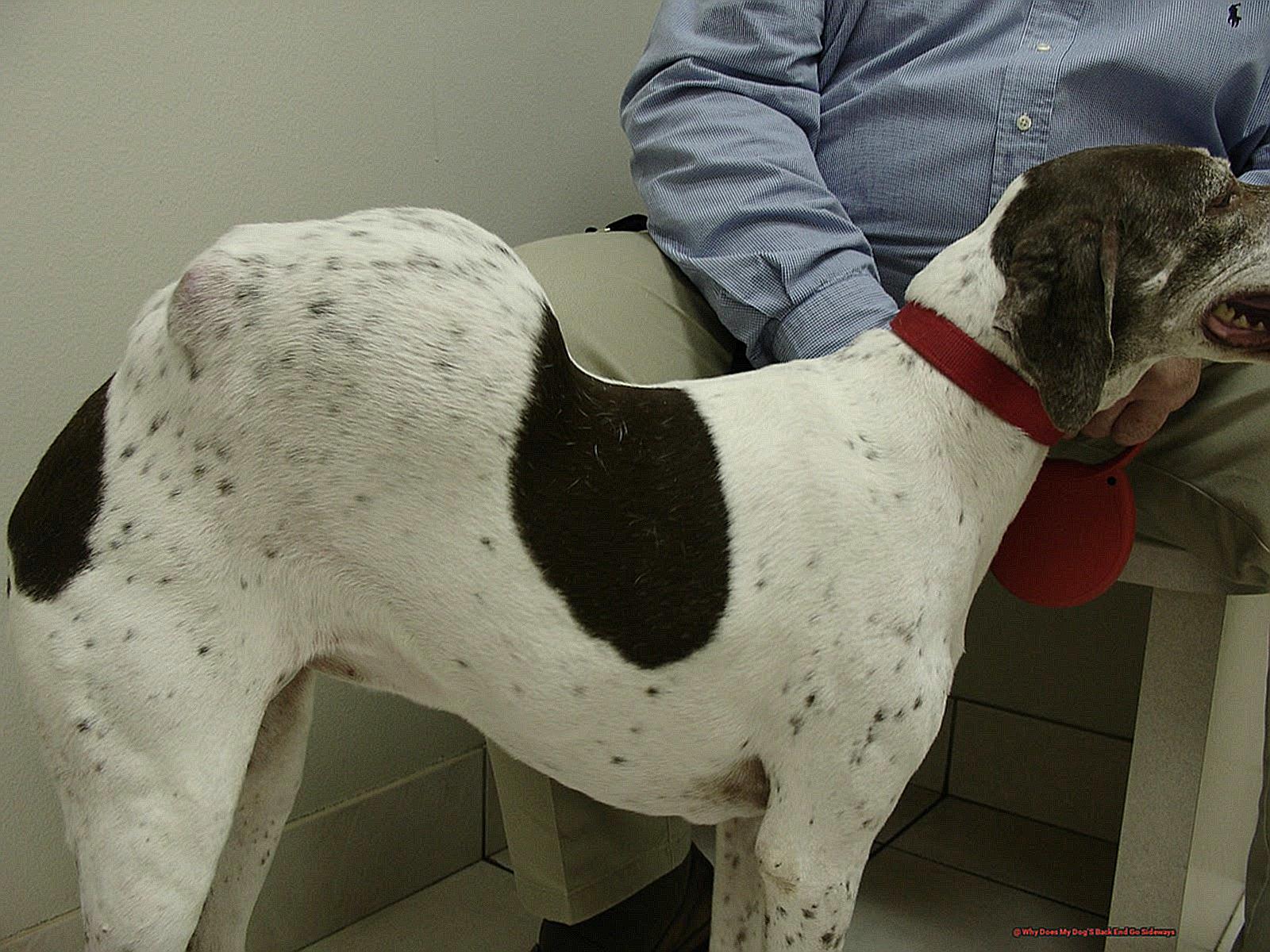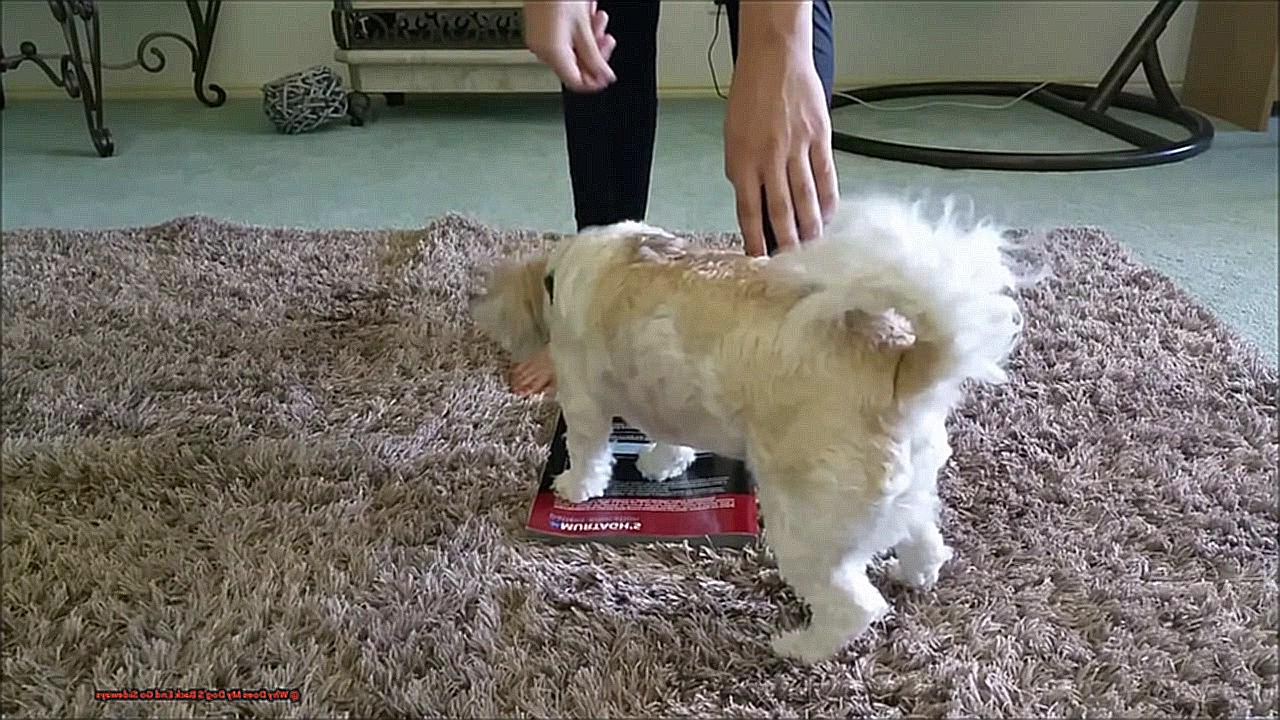Why Does My Dog’S Back End Go Sideways?
Picture this: you’re out for a walk with your furry best friend when suddenly, you notice their back end swaying from side to side.
It’s a curious and somewhat comical sight, but have you ever wondered why it happens? As a dog owner, I’ve often found myself pondering this very question.
So, I did some digging and discovered that there’s more to this sideways hind end phenomenon than meets the eye. In this post, we’ll explore the reasons behind our dogs’ wobbly walks and gain a better understanding of their unique anatomy and genetics.
So, let’s grab our pups and get ready to uncover the truth about why their back ends go sideways.
Why Does My Dog’S Back End Go Sideways?
Contents
- 1 Why Does My Dog’S Back End Go Sideways?
- 2 The Role of Muscle Weakness and Imbalance in Causing Sideways Movements
- 3 Potential Medical Conditions That Can Affect a Dog’s Back End
- 4 How Obesity and Lack of Exercise Can Contribute to Abnormal Gait
- 5 Signs to Look Out For: When Should You Consult a Veterinarian?
- 6 Diagnosis and Treatment Options for Dogs with Sideways Movements
- 7 Tips for Managing and Improving Your French Bulldog’s Mobility
- 8 Conclusion
Don’t worry; it’s not just your dog. This phenomenon, commonly known as “frenchy butt,” is prevalent in the breed and can also occur in other dog breeds. While it may seem like a quirky characteristic, it’s essential to understand the reasons behind this behavior and take necessary precautions to ensure your dog’s well-being.
So, why does a dog’s back end go sideways? Let’s dig into the details.
Genetic Trait and Anatomy:
One of the main reasons behind a dog’s back end going sideways is their anatomy. French bulldogs have a unique body structure, with a large chest, short legs, and a muscular back end. This conformation can affect their gait and cause their hindquarters to appear uneven while walking or running.
Additionally, French bulldogs have a genetic trait that causes a shorter spine and longer hind legs, resulting in an unbalanced body structure. This trait may contribute to frenchy butt as their hind legs have to work harder to support their weight.
Wide-set Hips:
Another contributing factor to frenchy butt is the breed’s characteristic wide-set hips. This feature can cause instability in their hindquarters, making them prone to swaying or going sideways while moving. While it may not be noticeable in younger dogs, it can become more apparent as they age or gain weight.
Weight Gain and Lack of Exercise:
Just like humans, dogs can also experience weight gain if they consume more calories than they burn. Unfortunately, French bulldogs are prone to obesity, which can put extra pressure on their joints and lead to abnormal movements. Additionally, if they have a sedentary lifestyle or lack regular exercise, they may experience muscle weakness and imbalances.
Underlying Medical Conditions:
In some cases, frenchy butt can be a sign of an underlying medical condition. For instance, hip dysplasia, a common condition in French bulldogs, can cause abnormal movements in the hind legs. Other potential causes include spinal issues, such as intervertebral disc disease or degenerative myelopathy, which can affect the nerves and muscles in the hindquarters.

Why Address This Behavior?
While frenchy butt may seem harmless, it can lead to more severe health issues if left untreated. For instance, muscle weakness can progress to muscle atrophy, making it challenging for your dog to walk or run. In severe cases, it can also lead to joint problems and chronic pain.
The Role of Muscle Weakness and Imbalance in Causing Sideways Movements
French bulldogs have a unique body structure that sets them apart from other dog breeds. Their front legs are often shorter and more muscular than their back legs, causing an uneven distribution of weight. This can put added strain on their muscles, leading to weakness and imbalances in their hind legs. Additionally, their short and stocky build puts them at a higher risk for health conditions such as hip dysplasia and spinal issues, which can further contribute to sideways movements.
Impact on French Bulldogs:
The sideways movements caused by muscle weakness and imbalances may seem harmless at first, but they can actually be quite concerning for your furry friend. Not only does it affect their mobility and coordination, but it can also lead to chronic pain and discomfort if left unaddressed. This is why it is crucial for owners to be aware of this issue and take proactive measures to help their dogs.
Addressing the Issue:
Regular exercise and physical therapy are essential in strengthening the muscles in a dog’s back end. Simple exercises such as gentle walks, swimming, or using a balance board can help improve balance and coordination. Physical therapy techniques, like massage and stretching, can also aid in strengthening weak muscles. In more severe cases, surgery may be necessary to correct any underlying health conditions that are contributing to the sideways movements.

Maintaining a Healthy Weight:
As with any dog breed, it is crucial for French bulldogs to maintain a healthy weight to prevent excess strain on their already weak muscles. As an expert, I recommend consulting with a veterinarian to determine the appropriate weight and feeding plan for your furry friend.
Potential Medical Conditions That Can Affect a Dog’s Back End
As a French Bulldog owner, you may have noticed your pup’s back end occasionally tilting or going sideways while walking or standing. While this may seem like a minor issue, it could be a sign of an underlying medical condition that requires attention. In this section, we will discuss some potential medical conditions that can affect a dog’s back end and cause it to go sideways.
Intervertebral Disc Disease (IVDD)
IVDD is a common spinal disorder in dogs that can lead to a dog’s back end going sideways. This condition occurs when the discs between the vertebrae become damaged or degenerate, causing pain and discomfort. Since French Bulldogs have long backs and short legs, they are more prone to IVDD due to the extra strain on their spine.
Hip Dysplasia
Hip dysplasia is another condition that can cause a dog’s back end to tilt or go sideways. It is a genetic disorder where the hip joint does not form correctly, leading to instability and pain. As a result, dogs may shift their weight to one side, causing their back end to go sideways. This condition is more common in large breeds like French Bulldogs and can develop at any age.
Arthritis
Arthritis is a degenerative joint disease that can also cause a dog’s back end to go sideways. It occurs when the protective cartilage in the joints wears down, leading to inflammation and pain. To alleviate this pain, dogs may shift their weight to one side, causing their back end to go sideways. Arthritis is more common in older dogs but can also affect younger dogs with joint abnormalities or injuries.
Injuries or Trauma
An injury or trauma to the spine or hind legs can also cause a dog’s back end to go sideways. Falls, accidents, or even rough play can lead to pain and discomfort, causing dogs to shift their weight to one side. If left untreated, these injuries can worsen and lead to more severe mobility issues.
Neurological Disorders
Degenerative myelopathy or cerebellar hypoplasia are neurological disorders that can cause a dog’s back end to go sideways. These conditions affect the nervous system and can cause weakness, lack of coordination, and muscle atrophy in the hind legs.
How Obesity and Lack of Exercise Can Contribute to Abnormal Gait
As a French Bulldog owner, you know how lovable and quirky these little pups can be. From their expressive faces to their energetic personalities, they never fail to make us smile.
However, did you know that their small size and love for food can put them at risk for developing an abnormal gait?
Obesity and lack of exercise are two factors that can contribute to your French Bulldog walking in a wobbly or sideways manner. Let’s take a closer look at why this happens and what you can do to prevent it.
The Impact of Obesity on Your Dog’s Gait
Just like humans, carrying excess weight can have a negative impact on a dog’s joints and muscles. When a French Bulldog is overweight, it puts extra strain on their tiny frame, making it difficult for them to walk properly. This can result in a sideways or wobbly gait as their body struggles to support the extra pounds.
Moreover, obesity can also lead to other health issues such as IVDD (Intervertebral Disc Disease), hip dysplasia, and arthritis. These conditions can further affect your dog’s gait and overall mobility.
The Role of Exercise in Your Dog’s Gait
In addition to maintaining a healthy weight, regular exercise is essential for your French Bulldog’s muscle strength and balance. Without enough physical activity, their muscles can weaken, making it harder for them to maintain proper balance while walking. This can cause their back end to sway or go sideways, resulting in an abnormal gait.
Breeds like French Bulldogs are already prone to certain health conditions due to their unique body structure. Being brachycephalic (having a shortened skull and flattened face) can also contribute to an abnormal gait as it affects their spine and overall body structure.
So, what can you do to prevent these issues from arising in your beloved Frenchie?
Tips for Maintaining a Healthy Gait
- Monitor Your Dog’s Weight: As a responsible owner, it is crucial to keep an eye on your French Bulldog’s weight. If you notice them gaining extra pounds, consult with your veterinarian to create a personalized weight loss plan.
- Provide a Healthy Diet: Along with regular exercise, a balanced and nutritious diet is crucial for maintaining a healthy weight in dogs. Avoid overfeeding and opt for high-quality, portion-controlled meals.
Signs to Look Out For: When Should You Consult a Veterinarian?
In this blog post, we will discuss the signs to look out for and when to consult a veterinarian if you notice your dog’s back end going sideways.
Sudden Change in Gait
One of the first signs to look out for is a sudden change in your dog’s gait or walking pattern. If you notice your dog’s back end going sideways, it could be a sign of an underlying issue such as hip dysplasia, which is common in French Bulldogs. This condition can cause your dog’s hips to become misaligned, leading to a wobbly and sideways gait.
Difficulty Standing Up or Reluctance to Move
Another sign to watch for is difficulty standing up or reluctance to move. If your dog seems to be having trouble getting up or seems hesitant to move, it could be due to pain or discomfort in their back end. This is especially concerning if it comes on suddenly and is accompanied by a sideways gait. It is important to monitor their movements and seek veterinary care if these symptoms persist.
Pain or Discomfort when Touched
In some cases, your dog may also exhibit signs of discomfort or pain when you touch their back end. This could be a clear indication that something is not right and warrants a visit to the veterinarian. Your veterinarian will be able to perform a thorough physical examination and may also recommend further diagnostic tests such as X-rays or blood work to determine the cause of your dog’s sideways back end.
Changes in Bowel Movements and Energy Levels
Keep an eye out for any changes in your dog’s bowel movements as well. If they are having trouble passing stool or seem to be in pain while doing so, it could be related to a problem in their back end.
Additionally, pay attention to any changes in your dog’s energy levels. If they seem more lethargic than usual and are not as active as they normally are, it could be due to an issue with their back end.
Diagnosis and Treatment Options for Dogs with Sideways Movements
As much as we love our French Bulldogs, we have to admit that their adorable waddle can sometimes be a cause for concern. While it may look cute, a sideways movement can actually be a sign of a bigger problem. As an expert in diagnosing and treating dogs with ataxia, I’m here to provide you with the information and resources you need to take care of your furry friend.
What is Ataxia?
Ataxia is a condition that affects a dog’s coordination and balance, causing them to have difficulty walking or standing up straight. It can manifest in various ways, including a sideways gait, staggering, or stumbling. In some cases, it may only affect the hind legs, while in others it can impact all four limbs.
What Causes Ataxia in French Bulldogs?
French Bulldogs are prone to developing spinal problems such as intervertebral disc disease and spinal stenosis. These conditions can put pressure on the nerves and lead to ataxia. Other potential causes include neurological disorders, musculoskeletal issues, or side effects from certain medications.
Why You Need to Consult with a Veterinarian
If you notice your French Bulldog exhibiting any kind of sideways movement, it is crucial to consult with a veterinarian as soon as possible. They will be able to properly diagnose the underlying cause and recommend the best course of action for your furry friend.
During the examination, your vet will likely perform a physical assessment to check for any signs of pain or discomfort. They may also recommend imaging tests such as X-rays or MRIs to get a better understanding of your dog’s condition.
Treatment Options for Ataxia
The treatment for ataxia will depend on the underlying cause. In some cases, medication may be prescribed to manage pain and inflammation. Physical therapy can also be beneficial in improving coordination and muscle strength. In more severe cases, surgery may be necessary to correct any structural issues.
It’s important to follow your vet’s recommendations and attend regular follow-up appointments to monitor your dog’s progress. In some cases, ataxia may require ongoing management to maintain your dog’s mobility and quality of life.
Tips for Managing and Improving Your French Bulldog’s Mobility
French bulldogs are known for their unique body structure and adorable personalities. But as much as we love them, we can’t deny that they are prone to certain health issues, one of which is mobility problems. As a French bulldog owner, it’s important to be aware of potential mobility issues and take proactive steps to manage and improve your furry friend’s mobility. In this blog post, we’ll discuss tips and tricks to help your French bulldog maintain a healthy weight, provide proper support, and seek professional advice.
Keep Your Frenchie at a Healthy Weight
One of the main reasons for a French bulldog’s back end going sideways is due to obesity. These small and compact dogs may look cute with a little extra weight, but it can have serious consequences on their joints and overall health. To maintain a healthy weight, it’s important to feed your dog a balanced diet and avoid overfeeding or giving too many treats. Consult with your veterinarian for personalized dietary recommendations based on your dog’s age, activity level, and health status.
Provide Proper Support
French bulldogs have a unique body structure, with a wide chest and short legs. This can put extra strain on their spine and joints, leading to mobility issues. To alleviate pressure on their body, it’s important to provide your dog with a comfortable and supportive bed. Beds with orthopedic features can help distribute weight evenly and provide relief for any existing joint discomfort.
Seek Professional Advice
Regular vet check-ups are crucial for identifying any potential issues early on. Your veterinarian can perform a physical exam and order X-rays if necessary to determine the cause of your dog’s mobility issues. They can also recommend specific supplements or treatments tailored to your dog’s needs.
Consider Physical Therapy or Alternative Treatments
In some cases, physical therapy or alternative treatments such as acupuncture can be beneficial for improving your French bulldog’s mobility. These treatments can help strengthen their muscles and improve joint flexibility, making it easier for them to move around comfortably.
Use a Harness Instead of a Collar
When walking your French bulldog, it’s important to use a harness instead of a collar. Collars can put pressure on their neck and spine, which can worsen existing conditions or lead to new ones. A harness distributes weight evenly and provides better control over your dog’s movements, making walks more comfortable and safer for them.
Be Aware of Limitations
Lastly, always be aware of your French bulldog’s limitations. Avoid activities that may put too much strain on their body, such as jumping or running on hard surfaces. Instead, opt for low-impact exercises like swimming or gentle walks. Regular exercise is crucial for maintaining healthy muscles and joints, but it’s important to consult with your veterinarian before starting any new exercise routine.
Also Read: Are C Sections Safe For Frenchies
Conclusion
In conclusion, as dog owners, we have all likely witnessed our furry companions’ back ends going sideways while walking and wondered why. But this seemingly odd behavior is not just a quirk of our pets; it can actually be a sign of underlying issues that require attention.
Through research, we have discovered that there are multiple factors at play when it comes to a dog’s wobbly gait. Unique anatomy, genetics, and potential health conditions all contribute to this phenomenon. For breeds like French bulldogs with wide-set hips and genetic predispositions, the sideways hind end movement is even more common.
However, as responsible pet owners, we must not overlook or dismiss this behavior. If left untreated, it can lead to more severe health problems for our beloved dogs. Muscle weakness and imbalances can also be significant contributors to these sideways movements.
Therefore, it is crucial for us to stay vigilant and recognize the signs of potential health issues that may affect our dogs’ mobility. Any sudden changes in gait or difficulty standing up should prompt a visit to the veterinarian. Maintaining a healthy weight through proper diet and exercise is also vital in preventing mobility problems.
If your French bulldog does experience mobility issues, there are various treatment options available. From physical therapy to medication, seeking professional advice from a veterinarian is essential in determining the best course of action for your dog’s specific needs.
Ultimately, by being proactive and providing proper support for our furry friends, we can help them maintain their mobility and live happy and healthy lives.




